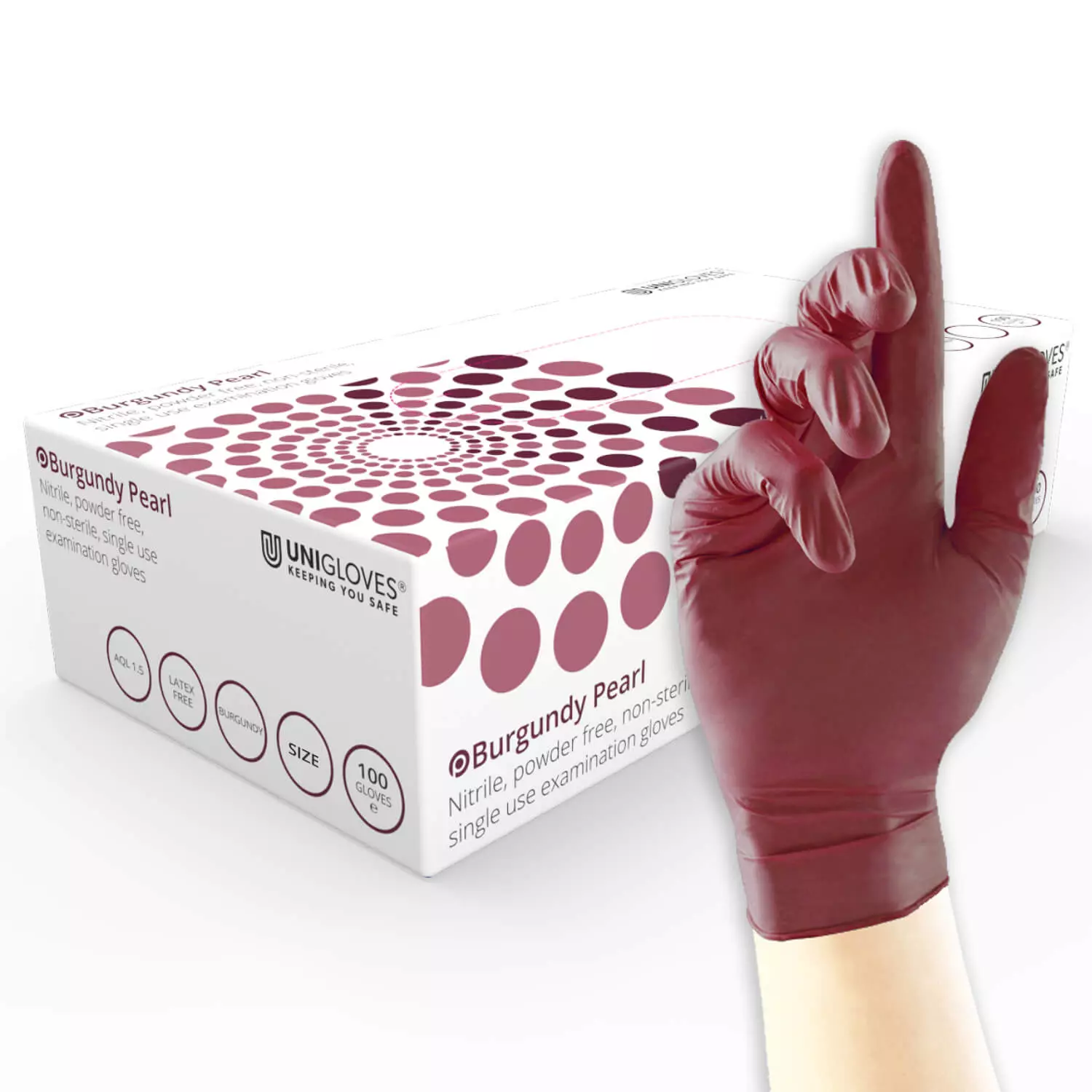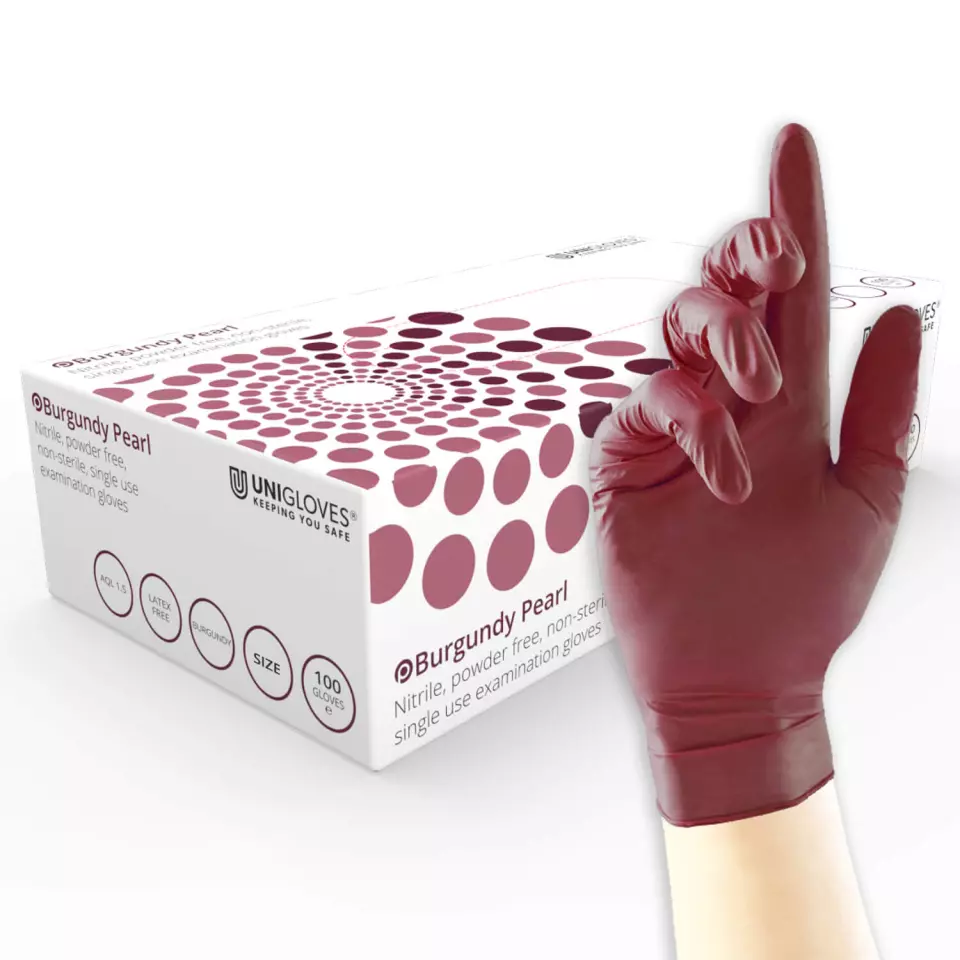
Unigloves Pearl Burgundy nitrile gloves
Unigloves Pearl Burgundy nitrile gloves
5 / 5


Features You'll Love

Finger Thickness · 0.1 mm
Measures the material thickness at the fingertips, affecting tactile sensitivity, dexterity, and protection level during use.
Measures the material thickness at the fingertips, affecting tactile sensitivity, dexterity, and protection level during use.
Measures the material thickness at the fingertips, affecting tactile sensitivity, dexterity, and protection level during use.
Unigloves
Pearl Burgundy nitrile gloves, 10 x 100 pcs
Pearl Burgundy nitrile gloves, 10 x 100 pcs
5 / 5
61,03 €
Price per 10 packages (1 000 pcs)
6,10 € / 100 pcs
Free delivery
Features You'll Love

Finger Thickness · 0.1 mm
Measures the material thickness at the fingertips, affecting tactile sensitivity, dexterity, and protection level during use.
Measures the material thickness at the fingertips, affecting tactile sensitivity, dexterity, and protection level during use.
Measures the material thickness at the fingertips, affecting tactile sensitivity, dexterity, and protection level during use.
Product description
• Tested to EN374
• Available in twelve colours
• AQL 1.5 and EN455 parts 1-4
• Free from latex
• Free from powder
• Free from phthalates
• Tested to EN1186
• Ambidextrous
• Manufactured using high-quality nitrile
• Nitrile formulation conforms to the hand during use
• Beaded cuff
• Manufactured with textured palms and fingertips
• Medium-weight construction
• Touchscreen compatible
• Tested to EN374
• Available in twelve colours
• AQL 1.5 and EN455 parts 1-4
• Free from latex
• Free from powder
• Free from phthalates
• Tested to EN1186
• Ambidextrous
• Manufactured using high-quality nitrile
• Nitrile formulation conforms to the hand during use
• Beaded cuff
• Manufactured with textured palms and fingertips
• Medium-weight construction
• Touchscreen compatible
• Tested to EN374
• Available in twelve colours
• AQL 1.5 and EN455 parts 1-4
• Free from latex
• Free from powder
• Free from phthalates
• Tested to EN1186
• Ambidextrous
• Manufactured using high-quality nitrile
• Nitrile formulation conforms to the hand during use
• Beaded cuff
• Manufactured with textured palms and fingertips
• Medium-weight construction
• Touchscreen compatible
Provides comfort and peace of mind, free from natural rubber latex to protect sensitive skin.
Phthalate-free for reduced chemical exposure, offering a safer choice for you and the items you handle.
Complete finger coverage ensures full protection and hygiene for your hands, maintaining dexterity for all tasks.
Easily wear on either hand, ensuring quick protection and less waste.
Total mass of the glove package, useful for shipping calculations, storage planning, and comparing product quantities across different brands.
Indicates how long gloves maintain their protective properties and quality when stored properly, typically measured in years from manufacture date.
Indicates the maximum percentage of defective gloves acceptable in quality testing, with lower numbers representing higher quality standards.
Measures the material thickness at the palm area, affecting protection level and tactile sensitivity during use.
Describes the surface texture of the fingertip area, affecting grip strength and tactile sensitivity during use.
Measures how far the glove extends up the wrist and forearm, determining the level of coverage and protection provided during use.
Measures the material thickness at the fingertips, affecting tactile sensitivity, dexterity, and protection level during use.
Measures the thickness of the glove's wrist/forearm extension, affecting durability, tear resistance, and protection level during use.
The base substance used to manufacture the glove, affecting chemical resistance, durability, flexibility, and compatibility with specific applications.
The visual appearance of the glove material, ranging from basic colors to specialized options for different professional and aesthetic preferences.
The texture of the glove exterior, affecting grip strength and handling capability for different tasks and working conditions.
Indicates whether gloves contain powder on the interior surface to aid donning, affecting ease of use and contamination control requirements.
- Chemical Resistance
- Clean Room
- Food Service
- Water Resistance
- Medical Protection
- Antimicrobial Protection
- Hand Protection
Protective gloves with the EN 374-4:2013 rating are tested for their resistance to degradation by chemicals. This measures changes in the glove material, like swelling or hardening, ensuring the glove maintains its protective qualities when exposed to hazardous substances.
Test results
This glove's material resists breaking down when in contact with specific chemicals. This helps protect you from physical changes to the glove like swelling, cracking, or softening that could compromise your safety during use.
Gloves with the EN ISO 374-1:2016 rating are tested for resistance against dangerous chemicals and microorganisms, including penetration, permeation, and degradation. This means you can choose gloves designed to protect your hands from specific chemical hazards, ensuring safer use in various tasks.
Test results
Provides splash protection against at least one specific chemical for more than 10 minutes. These gloves are suitable for tasks involving limited or short-duration contact with specified low-risk chemicals.
Gloves with the EN 374-5:2016 rating are tested for resistance to penetration by bacteria and fungi, and potentially viruses. This means the gloves provide a protective barrier against microorganisms, helping to keep your hands safe from harmful biological agents.
Test results
This glove is tested to protect you from bacteria, fungi, and viruses. It provides a reliable barrier, having passed specific tests to ensure no leakage when exposed to these micro-organisms, making it suitable for handling contaminated materials.
Gloves with the EN 374-2 rating are tested for resistance to penetration by liquids and microorganisms. This means the glove material is checked for physical defects like pinholes or leaks, ensuring it forms a barrier against harmful substances. You can trust these gloves to be waterproof and block microorganisms.
Single-use medical gloves with the EN 455-3 rating are tested for biological safety, including potential chemical residues, latex proteins, and powder content. This ensures the gloves are safe for skin contact, minimizing the risk of irritation or allergic reactions for users and patients.
Medical gloves with the EN 455-2 rating are tested for physical properties like dimensions and strength, including force at break both before and after aging. This ensures the gloves fit correctly, are durable, and provide reliable protection against cross-contamination for both patient and user.
Medical gloves with the EN 455-1 rating are tested for freedom from holes to ensure they act as an effective barrier. This means the gloves reliably protect users and others from the transmission of microorganisms and contamination.
Medical gloves with the EN 455-4 rating are tested for their shelf life, ensuring they maintain critical properties like strength and barrier integrity over time. This means you can trust that the gloves will remain effective and safe to use until their expiration date, providing reliable protection when needed.
Medical devices with the ISO 13485:2016 rating are tested for a quality management system that ensures consistent safety, quality, and regulatory compliance throughout their lifecycle. This provides assurance that the product is reliably produced to high international standards for patient use.
Test results
This product was made under a quality management system that ensures consistent design, production, and distribution. This focuses on the safety, performance, and regulatory compliance of medical devices throughout their entire lifecycle, from design to disposal.
Products from companies with the EN ISO 9001:2015 rating are tested for the company's systems for consistently providing quality products and services and meeting customer needs. This means the company is committed to consistent quality, aiming to meet your needs and improve its offerings, leading to more reliable products and better customer experience.
Test results
This certification shows a commitment to quality and consistency. It ensures the company's processes are managed to deliver reliable, effective service and a better customer experience from start to finish.
Gloves and other hand protection with the EN 420 rating are tested for general safety, comfort, and harmlessness of materials. This ensures the product fits well, allows for good hand movement, and won't cause irritation or allergic reactions during use.
Food safe refers to the safety of food products that are used or consumed by people. In Europe, food safety is regulated by the European Union (EU) and the European Food Safety Authority (EFSA). These organizations set standards and requirements for food products to ensure they are safe to eat. To be considered "food safe" in Europe, a product must meet these standards and be free of harmful substances. This includes being free of harmful bacteria, pesticides, and other contaminants. Food products that do not meet these standards cannot be sold or used in the EU.
PPE stands for "personal protective equipment." PPE Category 3 refers to equipment that is complex and provide the highest level of protection such as powered respirators, SCBA, and full body suits. In Europe, PPE Category 3 must meet certain safety standards set by the European Union, which means that it must be designed and manufactured to protect the user without causing harm. Companies that make or sell PPE must prove that it meets these standards. They also must have a quality management system in place, have to be audited regularly by a notified body and have to have a technical documentation.
Free delivery for all Unigloves products